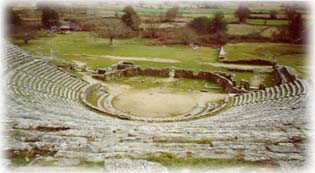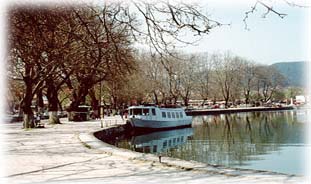
Ioannina is one of the most beautiful cities of Greece. Surrounded by abundant natural beauty and endowed with rich historical evidence, the city flourished through the times becoming an important financial and cultural center; a historic 'Metropolis of knowledge' reknown since the times of the great Byzantine Empire. The city, with a population of approximately 100,000 inhabitants, lies in the middle of a plain (600 m altitude), surrounded by mountains. The beautiful old town, trapped within the walls of its castle, spreads to the shores of the legendary lake of Pamvotis; the lake of Ioannina with its picturesque little island in the middle. Today, Ioannina acts as a commercial and cultural centre of the North-Western part of Greece. It is the capital of the province of Epirus, which is the most mountainous place in Greece. The city of Ioannina is about 450km north-west from Athens and about 60km south of the Albania border. The city boasts a wide range of sporting and recreational facilities including indoor swimming pools, football and basketball stadiums, theaters, cinemas, Art Galleries, Museums, dancing floors and many colourful bars and pubs. It is famous fo r its popular art of golden and silver jeweleries and wood sculpture. Within an hour's drive is the coastline of Ionian Sea with small harbour towns that link Ioannina with the Ionian Islands via fast ferries. Only a few kilometers away over the mountains, the ancient oracle of Dodoni silenced forever, awaits for the last pilgrims to come. To come and cherish the awesome view from its impressive amphitheater, dating from the 3d century B.C. Historic Ioannina
The word "Ioannina" is officially mentioned for the first time in the Acts of Constantinopole (879 A.D.), even though historical evidence relates the area to the Hellenistic Period (3rd century B.C.). The year 1082, Ioannina was occupied by the Normans. With the fall of the Byzantine Empire to the Latins (1204), Michael Comninos, a member of the last dynasty, established the Despotato (sovereignity) of Epirus (1205) and permited the settlement there of several families of the dislanding aristocracy of Costantinopole. A bright progress of Ioannina began to appear soon and a favorable climate for the development of culture and sciences was established. In 1335 the Despotato of Epirus united with the regenerated Byzantine State. After the conquest of Ioannina by the Serbians (1367) and the Italians (1385), the city came under the Turkish rule (1430), but with several privileges (e.g. the inviolable of the church, non settlement of Turks in the castle, etc). However, after the revolution of Dionysios Skylosophos in Ioannina, all these privileges were lost. By the end of the 18th century the famous Ali Pasha from Tepeleni became the ruler of Ioannina. He expanded his sovereignity beyond Epirus, to west Macedonia, Thessaly and the whole mainland of Greece. Later, Ali Pasha revolted against the Sultan and he wa s finally assassinated on the small island of the lake in 1822. The region of Epirus and the city of Ioannina was liberated by the Greek Army and united with the modern Greek State, after the flight at Bizani, on the 21st of February 1913.
Travelling to Ioannina Ioannina is connected by bus to Athens (7 hrs), Thessaloniki (6 hrs), Igoumenitsa (1.5 hrs, ferry boat connection to Italy and Corfu) and other important cities. The two bus stations are located downtown. The city also enjoys a modern airport at the distance of 4km from the city center and 10km from the University Campus with every-day flights to Athens (1 hr) and three flights per week to Salonica (40 min). There is also an international fliht per week to Tirana (Albania, 1 hr). |


